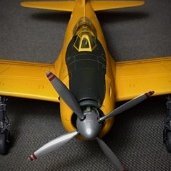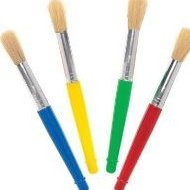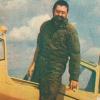-
Posts
1,141 -
Joined
-
Last visited
About MDriskill
- Currently Viewing Forum: Aircraft WWII
- Birthday 28/08/1954
Contact Methods
-
AIM
kyofu
Profile Information
-
Gender
Male
-
Location
Great Smoky Mountains
MDriskill's Achievements

Very Obsessed Member (5/9)
1.4k
Reputation
-
For what it's worth, the ancient Supermodel 1/72 kit of the C.202 includes underwing tanks. I'm guessing that (along with the rest of the kit) they aren't terribly accurate, but might be worth a look at least. The kit also includes some prototype parts: nose radiator, and gondola-mounted wing cannon. Got my copy of the new Caliaro book yesterday. WOW - really a first-rate production.
-

Macchi MC202 Folgore with Daimler Benz DB605 engine
MDriskill replied to GiampieroSilvestri's topic in Aircraft WWII
For what it's worth, here is what "Google translate" spit out: "One of the Aer.Macchi C. 202s re-engined by the Sannita Air Force with a DB.605 engine: it is the MM.9695, codes 21-15, which in the photos appears with two detachable wing tanks (the one under the left wing is visible) ; previously, from the examination of the Military Serial Numbers of the aircraft concerned, the transformation of three C.205 Veltros into the Escort version was certain, but the radio antenna, the tail boom, the fixed fairing of the rear wheel are those of a C .202. A third photo of this particular aircraft, taken from the front and part of the D'Amico-Valentini archive, certifies the re-engine with the DB.605; this aircraft belonged to one of the three squadrons of the 21st gr. when these had been included in the 51st Wing of the Regia Aeronautica during 1944. These "Escort" Aermacchi had been assigned, on the Nuova (Campobasso) airport, on 19 June 1944 to the 21st gr. (not receiving department insignia but only the small white numbers in the queue, 21 for the department and 15 for the individual number like the one in the photo or like the very similar one 21-08 whose photo was published years ago." -
Here are two drawings that recently appeared on Pinterest. They are low-res scans of original factory GA sections of the C.200 and C.202, originally drawn to 1:5 scale (NOTE: here the C.200 profile appears at a slightly larger scale than the C.202 one). I've highlighted the fuselage structural datum lines, which correspond to the engine thrust line, in red. The blue lines are located at the front face of frame 0 (firewall); front face of frame 4 (cockpit enclosure); and rear face of frame 18 (tail cone attachment). The number of fuselage frames and their spacing appears to be the same on each aircraft, though of course the cross-section shape of each one is very different. It also appears to me that all flying surfaces are located the same with respect to the datum line. It would be very interesting to see and compare the corresponding drawing for the C.201! My take (pure eyeball-based speculation!) would be that its fuselage section shapes were identical to the C.200 below the datum line; but that everything above the line - between the rear of the engine cowl until frame 14 or 15 in front of the fin - was significantly changed. I also note that its sliding canopy appears to be identical to that used on early C.200's...no need to re-invent that particular wheel.
-
Take a look at the Italian-made "Sky Models" and "Tauro Models" ranges. The SM sheets, if not literally generic, famously cram so many subjects on each one that they are quite useful for "grazing." Below is a Tauro sheet, and the SM sheet for the C.200. On my recent C.202 build, I discovered the 1/72 SM C.202 sheet (one of their earlier efforts) had some accuracy issues with fonts, colors, and sizes of some items. But still pretty impressive, and their later sheets seem better done. I have similarly chock-full SM sheets for the C.205, G.50, and CR.42. Aeromaster and some others have also done random Italian fighter sheets in 1/72. The recent-ish re-releases of the Hobby 2000 (ex-Hasegawa) C.202, and Italeri C.202 and C.205, also have excellent decals (by Cartograf in each case IIRC).
-
Thanks Graham! Still waiting for my copy of the book...I'm guessing the photo you describe is this very interesting one, which also recently popped up on Facebook...?
-

FW 190 Focke Wulf Monogram in 1 /48
MDriskill replied to Dieda's topic in Work in Progress - Aircraft
LOVED that kit as a kid, built several and it turned me into a lifelong Fw 190 fan (and still the ONLY 190 kit that makes it impossible to mess up the gear strut angles, lol). I don't recall ever having a problem with the canopy fit. The rear glass in your photo doesn't look like the correct original Monogram part. -
Thanks! New to me, and most impressive.
-
Does the new book shed any additional light on the previous lengthy - and ultimately fruitless - debate on recon cameras? 😑 https://www.britmodeller.com/forums/index.php?/topic/235111487-recce-macchis-c200-and-c202/page/2/
-
Again...I said the C.200 and C.202 wings were similar, not identical. My main point was that the 202's fuselage structure evolved in a more straightforward way than I had previously realized, which actually left all flying surfaces located identically in respect to the fuselage datum. The primary diffs in the C.200 and C.202 wings were a change from "pointy" to "rounded" airfoil profile, done by changing the detachable stamped LE section; and revised aileron balance weights, making an offset in the 202's aileron hinge line. The basic internal structure, plan geometry, dimensions including unequal spans, were not changed. Some late 200's actually had the 202 wing. The rounded LE (and minor revisions to the root fairings) and aileron details are obvious, and again point out that the core bits were shared all along. I've been a Macchi fan for many years and have a good library. It will be interesting to see if the book fills any gaps.
-
Graham, my intent was to show that the C.200 and C.202 evolved in an orderly way, with more basic structural and geometric similarities than are generally realized; not that they shared every minor detail. And that the C.201 prototype appears to fit in rather nicely. My post clearly failed to make that point - which in any case was an irrelevant side excursion from your original question - so I took it down. Thanks for your comments on the new book. I'm impatiently waiting for my copy to arrive.
-
I don't know the answers to your questions, but here is the book: https://kalmbachhobbystore.com/product/85058?gad_source=1&gclid=EAIaIQobChMIuKO38_fMhQMVKJ5aBR0wRQYqEAQYASABEgJiavD_BwE
-
Photos from Michael O'Leary's Building the P-51 Mustang. A really excellent book, with many previously unpublished factory archive photos. Early Allison-engine airframe: Two shots under a P-51B wing. The filled area underneath did not extend as far aft as on top: I am not qualified to question "Mr. Eduard," but of course the entire wing was not puttied; and any access hatches, removable sections, etc. in the sealed forward portions would also have visible gaps.
-
There's a good detailed build of the 1/35 Border Fw 190A-6 here that should answer most of your questions: https://forum.largescaleplanes.com/index.php?/topic/97808-border-135-fw-190a-6-nowotny-double-chevron/#comment-1420206 As noted above, there are some ridiculous misprints on the instruction sheet...apparently done by someone who didn't know a Focke-Wulf from a Messerschmitt! But the kit itself is outstanding. There are some very minor surface-detail inaccuracies from some slight confusion between variants (discussed in the linked thread). But the kit's shape accuracy, level of detail, and engineering are excellent.






